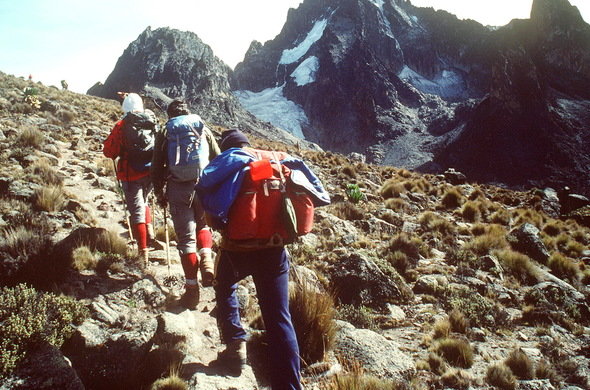Kenya Safaris:Mount Kenya Hiking

Small Groups.

Secured
Payments

Local Guides.

Easy Payments
About Trip
Mount Kenya is Africa’s second highest mountain at 5,199m (17,058 feet) and the highest of all Kenya Mountains.
Start With us?
Highest Mountain In Kenya
Climb Mount Kenya.
Mt Kenya Hiking, Mount Kenya Climbing, Mount Kenya Trekking, Climbing Africa Mountains, Climbing Mt Kenya, Walking on Mount Kenya, Mount Kenya Trekking Route, Naro Moru Route, Nanyuki, Sirimon Route on Mount Kenya, Ship tons Camp.
Africa Exclusive Tours
Conquering the highest mountain in Kenya, Mount Kenya, is an exhilarating event and the breath-taking views of the African sunrise from Point Lenana is a never-to-be-forgotten experience. This trek can be undertaken by any physically fit person and several routes up the mountain are shown below: –
Mount Kenya
Mount Kenya, Africa’s second highest mountain at 5,199m (17,058 feet) and the highest of all Kenya Mountains, is roughly circular, about 60km across at the 200mm contour, where the steep font hills rise out of the gentler slopes of the centered highlands. At the centre of the massif, the main peaks rise sharply from around 4,500m to the main summit of Batian 5,199m, Nelion 5,188m and point Lenana 4,985m. Other major summits on the mountain include Point Piggott 4,957m, Point Dutton 4,885 and Point John 4,883m. Of the three main peaks (Batian, Lenana and Nelion), only point Lenana can be reached by trekkers and the other two being only for technical climbers.
It is the second highest peak in Africa and stands some what unjustly in the shadow of it’s taller neighbour Kilimanjaro, which lies some 320km away in the south and is visible on a clear day. Kilimanjaro may see much more traffic – due to the possibility of summiting via several non-technical trekking routes and due to the sometimes dubious honor of being one of the Seven Summits – but Mount Kenya offers a wealth of excellent and diverse climbing possibilities on rock, snow and ice Mt. Kenya is an ancient volcanic mountain much older than Mt. Kilimanjaro. It’s believed to have once reached well above 600m. What is left today is volcanic plug which erosion has fashioned into the complex jagged outline of the central peaks.
What you expect to see
While trekking the Mt. Kenya, you will pass through the cultivated farmlands on the lower slopes as the trails pass through the rain forest, rich in trees of many species but noticeably camphor’s, then onto a bamboo zone growing to heights of more than 12m or more up through open moor land before reaching the moonscape of higher slopes. The forests are rich in wildlife including elephant, buffalo and monkeys with even the moor lands offering a long list of mammals including the rock hyrax, the nearest living relative of the elephant. Sunbirds, hyrax and soaring eagles make the walk around the peaks one of the most beautiful expeditions in the East African Mountains.
Getting to Mount Kenya from Nairobi
Mount Kenya is approximately 200km north of Nairobi, the capital of Kenya, and is comfortably accessible by road using a variety of transport options – buses, mini buses, taxi cab or a car hire will get you close to the mountain on the tarred roads to the nearest town: Naromoru town for Naro Moru route, Nanyuki town for Sirimon route and Chogoria town for Chogoria route. The last stretch from the nearest town to the various trailheads (typically +/- 25km) will be on dirt roads and these can be in poor condition (especially in wet weather) and require a 4WD, or an approach on foot.
When to Trek Mount Kenya
Although, Mount Kenya can be climbed all year round, the highest rainfall occurs between late March and the middle of May, and slightly less between late October and mid December. Maximum rainfall occurs in the forest belt and on the south-east side of the mountain where it reaches 2500mm. per year at 3000m. Rain and, higher up, snow can however be encountered at any time of year – even in the driest periods (January and February). Normally the drier seasons are associated with clear, dry weather which can last for many days on end. The best weather is generally in the mornings, and convectional rainfall, if any, tends to come in the mid-afternoon.
There are three main routes, which penetrate the forest and the moorland. The routes are: Naromoru route, Sirimon route and Chogoria route and each of which has something different to offer. The other routes which are dormant are the Timau Route, Burguret Route, Meru Route and Kamweti Route
Climbing Mount Kenya Sirimon route – The least used of the three main routes, but features the most gradual ascent profile and best acclimatization options and above all the most interesting since its on the drier side on the mountain. The route passes through impressive Yellowwood forests in the lower reaches and features abundant wildlife and beautiful alpine scenery higher up.
Climbing Mount Kenya Naro Moru route – The fastest route to point Lenana but not as scenic as the other two. It is often overcrowded with many climbers since it’s the most popular route compared to Chogoria route and Sirimon route.
Our Happy Clients!
Our Tanzania trip was fabulous. Spotting the Tree-climbing lions and Black Rhino was unforgettable. Thanks for fulfilling our dreams. We’ll be back soon!

Clara Smith
Thank you, Maasai Land Wonders Team, for your exceptional care during my 3 Months Volunteering program. A thousand thanks for an unforgettable experience.

Shelly Barns
Thank you, Edwin and your team, for an amazing 7-day trip. Your personal care and dedication made it unforgettable. 1000 thanks!

Jacob Luke
Contact us, We're at your Service.



Trusted by:

